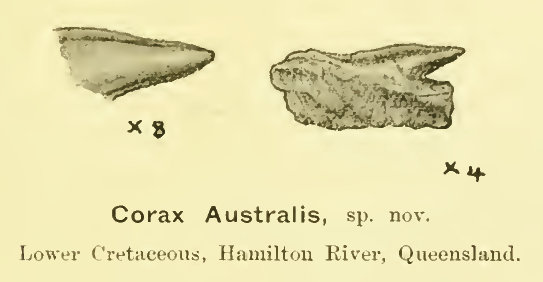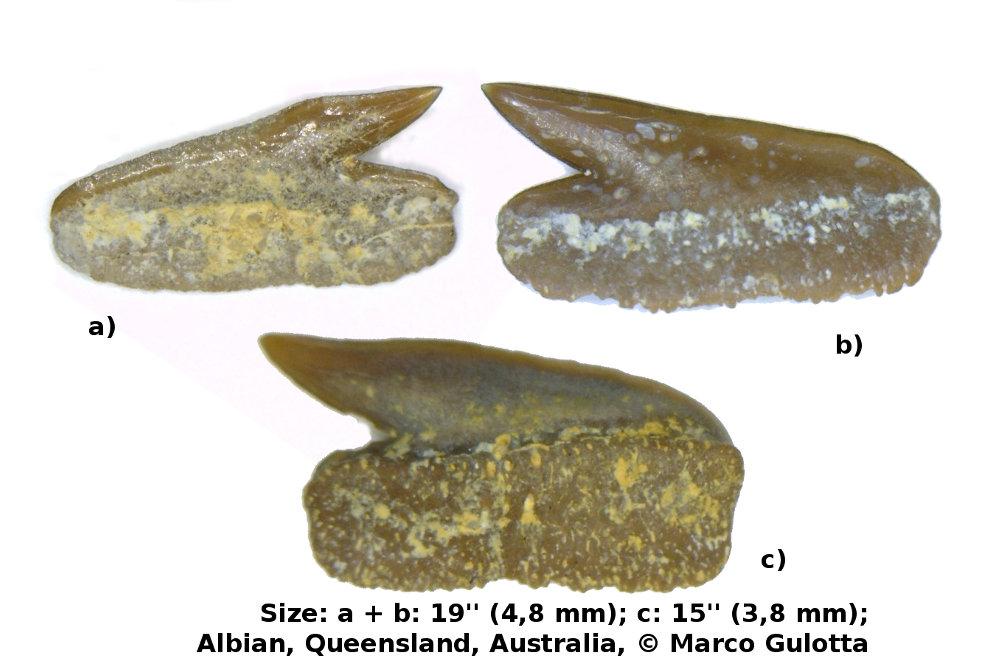Echinorhinus australis
(Chapman, 1909)
Classification: Elasmobranchii Echinorhiniformes Echinorhinidae
Reference of the original description
On the occurrence of the selachian genus Corax in the Lower Cretaceous of Queensland. Proceedings of the Royal Society of Victoria, 21, 452–453
On the occurrence of the selachian genus Corax in the Lower Cretaceous of Queensland. Proceedings of the Royal Society of Victoria, 21, 452–453
Image of the original description

Echinorhinus australis (Chapman, 1909); p. 453, fig.

Echinorhinus australis (Chapman, 1909); p. 453, fig.
Synonyms / new combinations and misspellings
Corax australis, Pseudocorax australis
Corax australis, Pseudocorax australis
Description by Pollerspoeck, Juergen:
Benediktinerring 34, D-94569 Stephansposching; juergen.pollerspoeck@shark-references.comCitation: Echinorhinus australis (Chapman, 1909): In: Database of fossil elasmobranch teeth www.shark-references.com, World Wide Web electronic publication, Version 12/2025
Please send your images of "Echinorhinus australis" to info@shark-references.com

Echinorhinus australis (Chapman, 1909), Albian, Toolebuc Formation, Queensland, Australia; © Marco Gulotta, Virginia, U.S.A.

Echinorhinus australis (Chapman, 1909), Albian, Toolebuc Formation, Queensland, Australia; © Marco Gulotta, Virginia, U.S.A.
Distribution Geographic
type locality: Hamilton River, about 40 miles from Boulia, Queensland [441];
other localities: near Richmond Woolgar Road, ca. 10 miles N of Richmond, Queensland, Australia (pers. comment Marco Gulotta, Virginia, U.S.A.);
Distribution of Echinorhinidae show google map
type locality: Hamilton River, about 40 miles from Boulia, Queensland [441];
other localities: near Richmond Woolgar Road, ca. 10 miles N of Richmond, Queensland, Australia (pers. comment Marco Gulotta, Virginia, U.S.A.);
Distribution of Echinorhinidae show google map
Distribution Stratigraphy
Rolling Downs Formation, Early Cretaceous, Albian [441]; Toolebuc Formation, Albian (pers. comment Marco Gulotta, Virginia, U.S.A.);
Rolling Downs Formation, Early Cretaceous, Albian [441]; Toolebuc Formation, Albian (pers. comment Marco Gulotta, Virginia, U.S.A.);
Measurement
holotype: Length of root, 5.5 mm ; entire length of crown, 6 mm ; height of root, 2 mm; height of crown from upper limit of root, 1.25 mm. [441];
holotype: Length of root, 5.5 mm ; entire length of crown, 6 mm ; height of root, 2 mm; height of crown from upper limit of root, 1.25 mm. [441];
Description
Original diagnosis after CHAPMAN, 1909 [441]: This specimen is evidently a young tooth, since the point of the crown is much depressed and acute. The base of the tooth is large in proportion, a characteristic of Corax, and is broadly wedge-shaped, tapering to the lower margin. There is no indication of an internal cavity to the tooth, as in Lamna and other allied genera. The anterior coronal margin is flexuous, and the depressed point makes it to be almost parallel with the basal margin of the root. It is the inner surface of the tooth which is exposed on the slab, and it is highly convex. The anterior and posterior coronal margins are depressed and flanged, and under magnification the edges are seen to be feebly crenate. Dimensions.—Length of root, 5.5 mm ; entire length of crown, 6 mm ; height of root, 2 mm ; height of crown from upper limit of root, 1.25 mm.
Original diagnosis after CHAPMAN, 1909 [441]: This specimen is evidently a young tooth, since the point of the crown is much depressed and acute. The base of the tooth is large in proportion, a characteristic of Corax, and is broadly wedge-shaped, tapering to the lower margin. There is no indication of an internal cavity to the tooth, as in Lamna and other allied genera. The anterior coronal margin is flexuous, and the depressed point makes it to be almost parallel with the basal margin of the root. It is the inner surface of the tooth which is exposed on the slab, and it is highly convex. The anterior and posterior coronal margins are depressed and flanged, and under magnification the edges are seen to be feebly crenate. Dimensions.—Length of root, 5.5 mm ; entire length of crown, 6 mm ; height of root, 2 mm ; height of crown from upper limit of root, 1.25 mm.
Discussion
described by CHAPMAN, 1909 as Corax australis [441]; figured in Kemp, 1991, pl. 4 [1275];
described by CHAPMAN, 1909 as Corax australis [441]; figured in Kemp, 1991, pl. 4 [1275];
Remarks
shark-references Species-ID=2059;
shark-references Species-ID=2059;
References

A review of Australia’s Mesozoic fishes. Alcheringa, 44(2), 286-311
DOI: 10.1080/03115518.2019.1701078

Of teeth and trees: A fossil tip-dating approach to infer divergence times of extinct and extant squaliform sharks. Zoologica Scripta, 47(5), 539–557
DOI: 10.1111/zsc.12299
Echinorhinus caspius, Echinorhinus richiardii, Echinorhinus pollerspoecki, Echinorhinus schoenfeldi, Echinorhinus cf. riepli, Echinorhinus priscus, Paraechinorhinus riepli, Echinorhinus sp., Echinorhinus pfauntschi, Echinorhinus blakei, Echinorhinus pozzii, Echinorhinus kelleyi, Echinorhinus weltoni, Echinorhinus eyrensis, Echinorhinus australis, Gibbechinorhinus lewyi, Orthechinorhinus pfeili, In Database of fossil elasmobranchteeth, www.shark–references.com, World Wide Web electronic publication, Version 04/2013

Oldest evidence of bramble sharks (Elasmobranchii, Echinorhinidae) in the Lower Cretaceous of southeast France and the evolutionary history of orbitostylic sharks. (plus Supplementary data). Cretaceous Research, 35, 81–87
DOI: 10.1016/j.cretres.2011.11.021


Chapter 15: Chondrichthyans in the Cretaceous and Tertiary of Australia. Vertebrate Palaeontology of Australasia: 497–568, 40 pl.


Chapter 15: Chondrichthyans in the Cretaceous and Tertiary of Australia. Vertebrate Palaeontology of Australasia: 497–568, 40 pl.

A catalogue of fossil fish in Queensland. Memoirs of the Queensland Museum, 20(3), 599–611
Australasian fossils, a students' manual of palaeontology. Chapter XII. Fossil fishes, amphibians, reptiles, birds, and mammals. Melbourne: Geo. Robertson & Co, p. 257–272

On the occurrence of the selachian genus Corax in the Lower Cretaceous of Queensland. Proceedings of the Royal Society of Victoria, 21, 452–453

A review of Australia’s Mesozoic fishes. Alcheringa, 44(2), 286-311
DOI: 10.1080/03115518.2019.1701078

Of teeth and trees: A fossil tip-dating approach to infer divergence times of extinct and extant squaliform sharks. Zoologica Scripta, 47(5), 539–557
DOI: 10.1111/zsc.12299
Echinorhinus caspius, Echinorhinus richiardii, Echinorhinus pollerspoecki, Echinorhinus schoenfeldi, Echinorhinus cf. riepli, Echinorhinus priscus, Paraechinorhinus riepli, Echinorhinus sp., Echinorhinus pfauntschi, Echinorhinus blakei, Echinorhinus pozzii, Echinorhinus kelleyi, Echinorhinus weltoni, Echinorhinus eyrensis, Echinorhinus australis, Gibbechinorhinus lewyi, Orthechinorhinus pfeili, In Database of fossil elasmobranchteeth, www.shark–references.com, World Wide Web electronic publication, Version 04/2013

Oldest evidence of bramble sharks (Elasmobranchii, Echinorhinidae) in the Lower Cretaceous of southeast France and the evolutionary history of orbitostylic sharks. (plus Supplementary data). Cretaceous Research, 35, 81–87
DOI: 10.1016/j.cretres.2011.11.021


Chapter 15: Chondrichthyans in the Cretaceous and Tertiary of Australia. Vertebrate Palaeontology of Australasia: 497–568, 40 pl.


Chapter 15: Chondrichthyans in the Cretaceous and Tertiary of Australia. Vertebrate Palaeontology of Australasia: 497–568, 40 pl.

A catalogue of fossil fish in Queensland. Memoirs of the Queensland Museum, 20(3), 599–611
Australasian fossils, a students' manual of palaeontology. Chapter XII. Fossil fishes, amphibians, reptiles, birds, and mammals. Melbourne: Geo. Robertson & Co, p. 257–272

On the occurrence of the selachian genus Corax in the Lower Cretaceous of Queensland. Proceedings of the Royal Society of Victoria, 21, 452–453

















